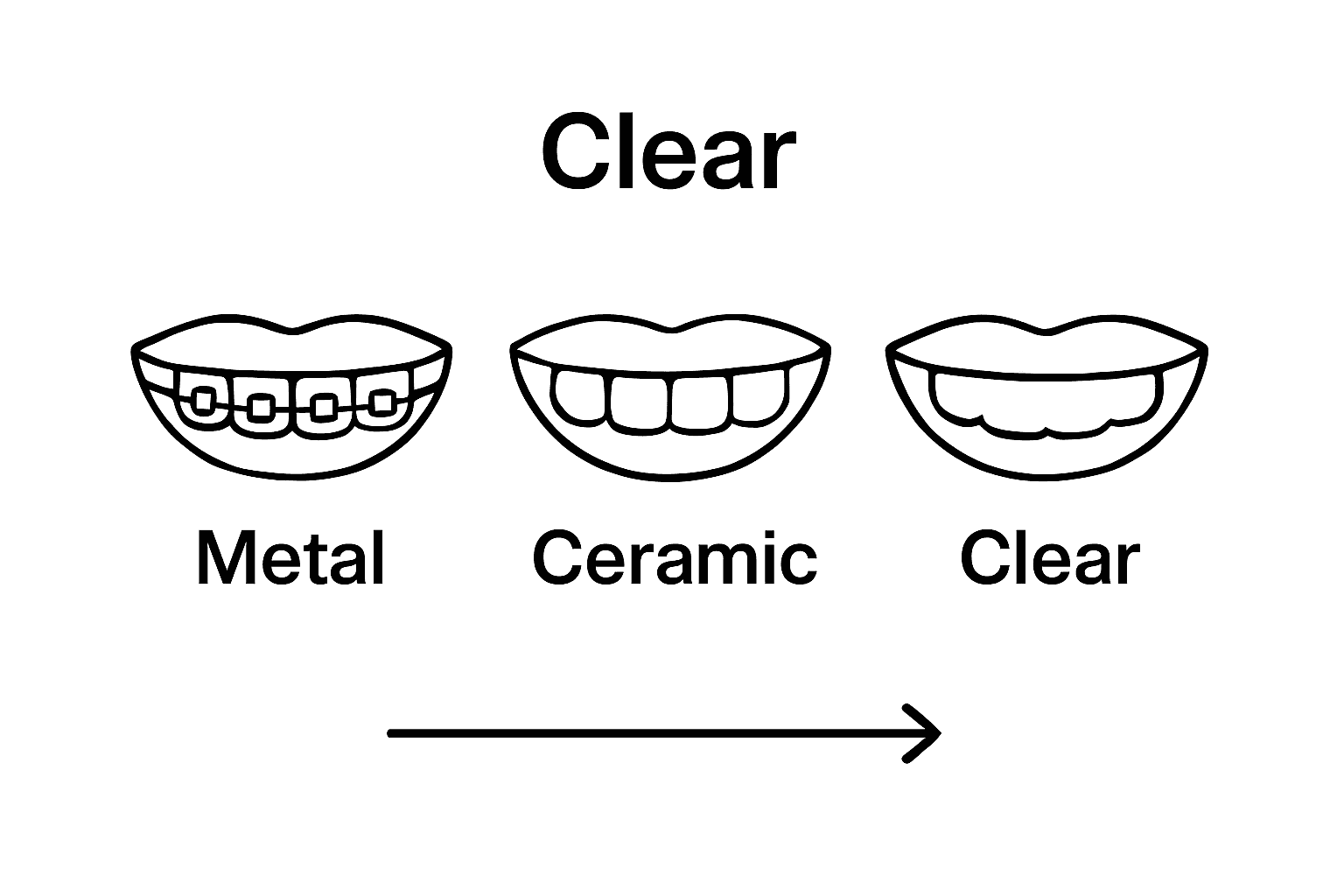Understanding How Braces Move Teeth: A Comprehensive Guide
October 2, 2025
Understanding How Braces Move Teeth: A Comprehensive Guide
Braces are more than just wires and brackets glued onto teeth. Millions of Americans wear braces at some point in their lives, with some moving their teeth at a pace of just one millimeter per month. That sounds slow and uncomfortable, right? Actually, this gentle pace is what makes the process not only safe but surprisingly effective, sparking a complete biological transformation in your mouth you probably never even realized was happening.
Table of Contents
- What Are Braces And How Do They Work?
- The Importance Of Teeth Movement In Orthodontics
- The Biology Of Tooth Movement Through Braces
- Different Types Of Braces And Their Functions
- Key Factors Influencing The Effectiveness Of Braces
Quick Summary
| Takeaway | Explanation |
|---|---|
| Braces apply strategic pressure | Braces use constant, gentle pressure to gradually reshape teeth and jaw positioning. |
| Bone remodeling is key | Constant pressure triggers a biological response, breaking down and rebuilding bone tissue to enable tooth movement. |
| Patient engagement enhances success | Active participation, such as adhering to appointment schedules and maintaining oral hygiene, significantly influences treatment effectiveness. |
| Orthodontic options vary | Different types of braces, including metal and ceramic, provide various benefits to meet individual patient needs. |
| Proper alignment improves oral health | Correctly positioned teeth promote better bite mechanics, speech, and overall oral hygiene, reducing future dental issues. |
What Are Braces and How Do They Work?
Orthodontic braces represent a specialized dental technology designed to systematically transform tooth alignment and jaw positioning through precise mechanical intervention. These devices function as sophisticated movement systems that apply strategic, consistent pressure to gradually reshape an individual’s dental structure.
The Fundamental Components of Braces
Braces consist of several critical components that work together to create controlled tooth movement.
This table summarizes the fundamental components of braces, providing quick reference for patients curious about how each part contributes to the overall process of tooth movement.
| Component | Description | Function in Braces |
|---|---|---|
| Brackets | Small metal or ceramic attachments bonded to teeth | Anchor archwires, guide movement |
| Archwires | Thin metal wires threaded through the brackets | Apply consistent pressure |
| Ligatures | Small elastic bands connecting wires to brackets | Secure archwires in place |
- Brackets: Small metal or ceramic attachments bonded directly to each tooth’s surface
- Archwires: Thin metal wires threaded through the brackets that apply consistent pressure
- Ligatures: Small elastic bands that connect the archwires to the brackets
The Biomechanical Process of Tooth Movement
The science behind how braces move teeth involves complex biological mechanisms within the jawbone and surrounding tissues.
When constant, gentle pressure is applied to a tooth, it triggers a remarkable biological response known as bone remodeling. This process involves simultaneously breaking down bone tissue on one side of the tooth while building new bone tissue on the opposite side.
Bone Remodeling Steps:
- Pressure application creates cellular signals in the periodontal ligament
- Osteoclasts begin breaking down bone tissue in the pressure direction
- Osteoblasts simultaneously generate new bone tissue in the tension direction
This intricate process allows teeth to slowly and safely shift into their desired positions without causing structural damage. Research from the National Institutes of Health confirms that this gradual movement ensures minimal discomfort and maximum effectiveness.
The entire orthodontic process requires precision, patience, and professional expertise to guide teeth into optimal alignment, transforming not just an individual’s smile but potentially improving overall oral health and functionality.
The Importance of Teeth Movement in Orthodontics
Teeth movement represents a critical aspect of orthodontic treatment that extends far beyond cosmetic improvements. By systematically repositioning teeth, orthodontists can address complex functional challenges that impact overall oral health and an individual’s quality of life.
Functional Benefits of Proper Dental Alignment
Correct tooth positioning plays a pivotal role in numerous aspects of oral functionality. Research from the National Institutes of Health demonstrates that proper dental alignment contributes to several essential physiological functions:
- Improved Bite Mechanics: Ensures even distribution of chewing forces
- Enhanced Speech Clarity: Proper tooth positioning supports accurate pronunciation
- Reduced Risk of Dental Wear: Prevents uneven tooth erosion and potential structural damage
Comprehensive Health Implications
Beyond immediate dental concerns, strategic teeth movement addresses broader health considerations. Misaligned teeth can trigger a cascade of interconnected health challenges that extend well beyond the mouth. Potential systemic impacts include:
- Increased risk of periodontal disease
- Potential jaw joint (TMJ) complications
- Challenges with proper oral hygiene maintenance
Long-Term Physiological Transformations
Orthodontic intervention through precise teeth movement represents a nuanced approach to restructuring an individual’s dental landscape. The process involves more than simple mechanical adjustment it triggers complex biological responses within the oral ecosystem.
The strategic repositioning of teeth stimulates bone remodeling, encourages proper jaw development, and can potentially mitigate future dental complications. By addressing alignment issues early, orthodontic treatments prevent potential chronic problems that might emerge if left unaddressed.
Ultimately, teeth movement in orthodontics is a sophisticated blend of medical science and personalized treatment, targeting not just aesthetic improvements but comprehensive oral health optimization.
The Biology of Tooth Movement Through Braces
The mechanism of tooth movement through braces represents a fascinating interplay of biological processes that transform dental positioning through precise mechanical intervention. This intricate biological dance involves complex cellular interactions that enable gradual, controlled tooth relocation.
Cellular Dynamics of Tooth Displacement
Research from the National Institutes of Health reveals that tooth movement occurs through a sophisticated biological response triggered by orthodontic pressure. When braces apply consistent force, several key biological mechanisms activate:
- Mechanical Stress Initiation: Pressure stimulates cellular signals in the periodontal ligament
- Cellular Remodeling: Specific cells begin restructuring bone tissue around the tooth
- Adaptive Response: Surrounding tissues adjust to accommodate new tooth positioning
Molecular Signaling in Bone Remodeling
The process of tooth movement involves intricate molecular communication within the oral biological system. Key cellular actors in this transformation include:
- Osteoclasts: Cells responsible for breaking down bone tissue
- Osteoblasts: Cells that generate new bone structures
- Periodontal ligament cells: Mediators of mechanical stress response
Biomechanical Transformation Mechanism
Orthodontic force creates a controlled inflammatory response that enables tooth repositioning. As pressure is applied, one side of the tooth experiences compression while the opposite side experiences tension. This differential pressure triggers a remarkable biological process where bone tissue is simultaneously broken down and rebuilt.
The precise balance of mechanical force determines the effectiveness of tooth movement. Too little pressure results in minimal change, while excessive force can cause damage to the tooth and surrounding tissues. Orthodontists carefully calibrate the amount of pressure to ensure safe, gradual, and predictable tooth repositioning.
Ultimately, tooth movement through braces exemplifies the remarkable adaptability of human biological systems, transforming dental structure through a delicate interplay of mechanical intervention and cellular response.
Different Types of Braces and Their Functions
Orthodontic treatment offers multiple brace options, each designed to address specific dental alignment challenges while accommodating individual patient preferences and clinical requirements. The diversity of available orthodontic solutions ensures personalized approaches to teeth straightening.
Traditional Metal Braces
Classic and Reliable: Metal braces represent the most traditional and widely recognized orthodontic intervention. According to the Mayo Clinic, these braces consist of metal brackets and wires that apply consistent pressure to gradually move teeth into desired positions:
- Highly Effective: Suitable for complex dental misalignments
- Cost-Efficient: Generally the most affordable orthodontic option
- Durable: Withstand significant mechanical pressure
Advanced Aesthetic Alternatives
Modern orthodontics has expanded beyond traditional metal solutions, offering more aesthetically pleasing alternatives that maintain robust therapeutic effectiveness:

- Ceramic Braces: Tooth-colored brackets that blend with natural tooth enamel
- Lingual Braces: Installed behind teeth for complete invisibility
- Clear Aligners: Removable transparent trays that offer maximum discretion
Specialized Orthodontic Technologies
Each brace type presents unique advantages tailored to specific clinical scenarios. Clear aligners, for instance, provide unprecedented flexibility for patients seeking less invasive treatment. Key considerations when selecting braces include:
- Severity of dental misalignment
- Patient age and lifestyle
- Budget and aesthetic preferences
- Anticipated treatment duration
The selection of braces transcends mere cosmetic choice. It represents a sophisticated medical decision involving comprehensive assessment of dental structure, functional requirements, and individual patient needs. Orthodontists carefully evaluate multiple factors to recommend the most appropriate intervention, ensuring optimal therapeutic outcomes and patient comfort.
Below is a table outlining the different types of braces discussed in the article, along with their key features and benefits for patients seeking orthodontic treatment.
| Type of Braces | Appearance | Key Benefits | Unique Characteristics |
|---|---|---|---|
| Traditional Metal | Metal brackets and wires | Highly effective, cost-efficient, durable | Suitable for complex misalignments |
| Ceramic | Tooth-colored brackets | Aesthetic, blends with natural teeth | Less noticeable than metal braces |
| Lingual | Brackets behind teeth | Completely invisible from the front | Customized to fit behind teeth |
| Clear Aligners | Transparent trays | Removable, maximum discretion | Offers flexibility, easy to clean |

Key Factors Influencing the Effectiveness of Braces
Successful orthodontic treatment involves a complex interplay of biological, mechanical, and patient-specific factors that collectively determine the ultimate effectiveness of dental alignment strategies. Understanding these interconnected elements helps patients and orthodontists optimize treatment outcomes.
Patient-Specific Biological Considerations
Individual biological variations play a critical role in orthodontic treatment responsiveness. Factors such as bone density, tissue regeneration capacity, and genetic predisposition significantly impact how effectively teeth can be repositioned:
- Bone Density: Determines rate of tissue remodeling
- Age Factor: Younger patients typically experience faster tooth movement
- Hormonal Influences: Can affect bone metabolism and tissue adaptation
Treatment Compliance and Engagement
Research on orthodontic patient compliance demonstrates that patient involvement is crucial for successful outcomes. Critical engagement factors include:
- Regular orthodontic appointment attendance
- Proper maintenance of orthodontic appliances
- Following prescribed oral hygiene protocols
- Adhering to dietary recommendations
- Wearing supplementary appliances as instructed
Mechanical and Technical Precision
The technical execution of orthodontic treatment involves sophisticated mechanical principles that require precise calibration. Key technical considerations encompass:
- Accurate initial dental assessment
- Precise bracket placement
- Calculated and controlled mechanical force application
- Continuous monitoring and adjustment of treatment progression
- Selection of appropriate orthodontic technology
The effectiveness of braces extends beyond simple mechanical movement. It represents a nuanced medical intervention requiring holistic understanding of individual physiological responses, patient commitment, and expert technical implementation. Successful orthodontic treatment emerges from the seamless integration of biological potential, patient dedication, and professional expertise.
Ready for a Confident, Healthier Smile? Your Journey Starts Here
After learning how braces gently move teeth by applying consistent pressure and triggering natural bone remodeling, you may be facing questions about your own dental alignment. Perhaps you are struggling with discomfort from misaligned teeth, difficulty chewing, or concerns about long-term oral health. Maybe you want a personalized approach that not only improves your smile but supports lasting dental wellness. At Glow Orthodontics, we understand that embarking on orthodontic care involves trust, detailed knowledge, and a partner who truly listens.

Discover how our experienced team uses the latest in orthodontic science—including clear aligners and traditional braces—to create smiles as unique as you are. With a welcoming environment and tailored solutions for families and individuals in Langley, we help you start with a thorough consultation and treatment process, supported by patient stories and clear next steps. Schedule a visit at Glow Orthodontics today to experience the caring, professional difference for yourself. Secure your spot now for a healthier, happier smile that lasts.
Frequently Asked Questions
What are the main components of braces?
Braces consist of brackets, archwires, and ligatures, which work together to apply pressure to teeth, gradually moving them into the desired positions.
How do braces move teeth?
Braces move teeth through a process known as bone remodeling. When consistent pressure is applied to a tooth, it triggers a biological response that breaks down and rebuilds bone tissue, allowing teeth to shift into new positions safely.
What are the different types of braces available?
There are several types of braces, including traditional metal braces, ceramic braces, lingual braces, and clear aligners. Each type offers unique aesthetic and functional benefits tailored to individual patient needs.
How long does orthodontic treatment typically take with braces?
The duration of orthodontic treatment with braces varies based on the complexity of the dental misalignment, but it generally ranges from several months to a few years. Regular orthodontic consultations and treatment compliance can help ensure efficient progress.